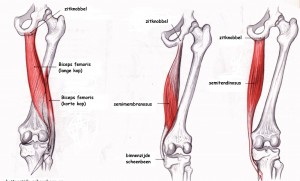Tight hamstrings are a problem for far too many people. Tight muscles in general limit joint rotation and range of motion.
If you have tight hamstrings it will be difficult to bend forward from a standing and sitting position among other possible issues.
Tight hamstrings make it especially hard to align the pelvis correctly because they pull the pelvis down into its habitual tuck.
Poor posture is both why so many people have tight hamstrings and why these individuals often find it difficult to change the nature of their tight hamstrings through traditional exercise.
It is important to note that there are plenty of people who are too loose in their musculature and their poor posture will not make their hamstrings tighter.
Those kinds of people, of whom I am one, have their problems to deal with.
After a class I taught today I mentioned to someone that most people have their exercise concepts backwards.
They think that they exercise to make their posture and movement patterns better. In fact, I think people need better posture to make exercise more accessible.
That might sound counterintuitive but I’ll try to explain.
I think that most tight hamstrings are that way because of their relationship to the femur bone and their resting length.
The hamstrings run from the ischial tuberosities, the sitting bones, at the base of the pelvis, to the tibia and fibula of the shin.
For the most part, the hamstrings don’t connect to the leg bone. Only one of the hamstrings connects to the femur, and in that case, it is only the short head of the biceps femoris connecting a good way down the femur toward the knee.
If you choose to believe my take on posture, everyone tucks their pelvis under, which forces the thigh bones forward so they are no longer directly under the hips.
As a result of the tucked pelvis the sitting bones are lower and closer to the shins shortening the resting length of the hamstring.
And the thigh bone and the hamstring are drawn apart from each other creating greater distance between the two.
When a person whose thighs are leaning forward goes to bend over from either sitting or standing, the legs actually move more correctly under the hips (except for the loose people who can often go too far in the other direction) but there is no availability for the shortened hamstrings to go with them; they can’t extend to where they would be if the legs lived under the pelvis during the course of the day.
Untuck your pelvis and get your legs to fall directly under your hips and over time the tight hamstrings will shift closer to the bone and have a better chance of lengthening.
This might not be easy at first due to the shortened resting length of the hamstrings but perseverance will pay off.
There is a similar postural explanation for why people go to yoga and stretch their quadriceps muscles forever without changing them much.
I’ll cover that in another post but suffice to say the hamstrings and quadriceps are two peas in a pod, messed up way more by our day to day posture than by our exercise routines.

